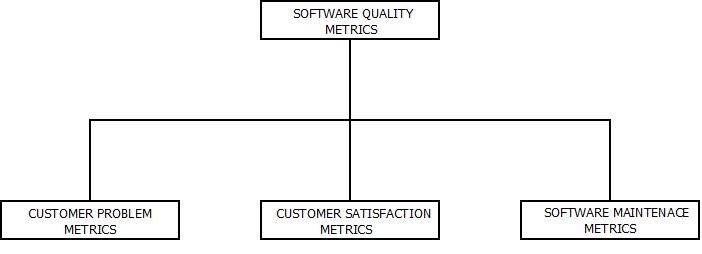Software Quality Metrics : Introduction
- Software quality metrics means the ability of a software product to be and to perform as per the standard defined. Metric means standards.
- The software quality metrics ensures that the software product is of highest quality and standard.
- There are three major software quality metrics. These are:

Software Quality Metrics
Software Quality Metrics : Customer Problem Metrics
- The quality metrics used in software industry that is responsible for measuring the problems encountered by the customers while using the product.
- From the customers point of view, all the problems they encountered while using the software product are problems with the software including the valid defects.
- The usability problems, unclear documentation and errors are the problems that cannot be considered as valid defects.
- The customer problem metrics is usually expressed in terms of problems per unit month i.e. PUM.
PUM =Total problems reported by a customer for a period of time + Total number of license months of the software during the period.
Here,
No of license months = Number of install licenses of software * Number of months in calculation period.
- PUM is usually calculated for each month after the software is released to the market, and also for monthly averages by year.
Software Quality Metrics : Customer Satisfaction Metrics
- Customer Satisfaction Metric deals with the overall quality of the product and how much a customer is satisfied with that software product.
- Customer satisfaction is often measured by customers survey data via a five point scale. These are:
- Very Satisfied.
- Satisfied.
- Neutral.
- Dissatisfied.
- Very Dissatisfied.

Customer Satisfaction Metrics
- Based on a five point scale data, several metrics with slight variations can be constructed and used. These are:
- Percentages of completely satisfied customers.
- Percentage of satisfied customers.
- Percentage of dissatisfied customers.
- Percentage of non-satisfied customers.
Note: Generally, ”Percentage of satisfied customers is used.”
- Net Satisfaction Index(NSI) is also used by some companies for customer satisfaction metrics.
- The net satisfaction index ha following weighing criteria:
- Completely Satisfied = 100%.
- Satisfied = 75%.
- Neutral = 50%.
- Dissatisfied = 25%.
- Completely Dissatisfied = 0%.
Software Quality Metrics : Software Maintenance Metrics
- A software product can be called as in maintenance phase when its development is complete and is released to the market.
- During this interval, the defect arrival by time interval and customer problem is called as de facto metrics.
- Also, the number of defect or problems arrived mainly depends upon the development phase and not on the maintenance phase.
- Therefore, certain metrics are required for software maintenance. These are:
- Backlog Management Index(BMI)
- The metric that is used to manage the backlog of open and unresolved problems. It can be defined as:
BMI = (Number of problems closed during the month * 100)/(Number of problems arrived during the month) - Fix Response Time(FRT)
- While developing the software product, certain guidelines regarding reporting of defect are made. It includes the guideline for time limit of fixes that must available against the reported defects.
- The fix response time for more severe defects is low and the fix response time for less severe defect is high.
- The fix response time metric can be calculated as:
FRT = (Mean time of all problems from open to closed)
- Fix Quality
- Fix quality of software product is the number of defects fixed.
- Every software product contains defects. But, Fix Quality ensures that the defects in software product are fixed on time as per the quality standard.
- Fix quality ensures that the fixes for the defects should not turn out to be defective.
- A fix can be called as defective if it does not fixes the problems and generates new problems in that software product.